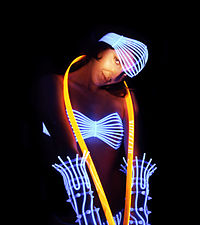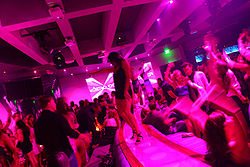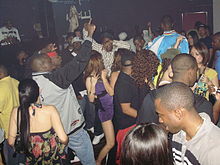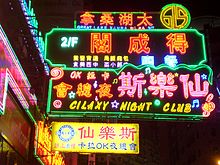- Nightclub
-
For other uses, see Night Club.
A nightclub (also known as a discothèque, or simply a club or disco) is an entertainment venue which usually operates late into the night. A nightclub is generally distinguished from bars, pubs or taverns by the inclusion of a dance floor and a DJ booth, where a DJ plays recorded dance, hip hop, rock, reggae, dubstep and pop music.
The music in nightclubs is either live bands or, more commonly, a mix of songs played by a DJ through a powerful PA system. Most clubs or club nights cater to certain music genres, such as techno, house music, trance, heavy metal, garage, hip hop, salsa, dancehall, Drum and Bass, Dubstep or soca music. Many clubs also promote playing the Top 40 which has most of the night playing the most broadcast songs of the previous week.
Contents
Entry criteria
Many nightclubs choose who can enter, on bases other than just age, e.g. dress code and guest list. This is used to make their status as a nightclub more "exclusive". Quite often, there are no clear policies governing entry to a nightclub, thereby allowing the doormen to deny entry to anybody at their discretion.
Cover charge
In most cases, entering a nightclub requires a flat fee called a cover charge. Early arrivers and women may have their cover charge waived or reduced (in the United Kingdom, this latter option is illegal under the Equality Act 2010[1] but the law is rarely enforced and open violations are frequent). Friends of the doorman or the club owner may gain free entrance. Sometimes, especially at larger clubs in continental European countries, one only gets a pay card at the entrance, on which all money spent in the discothèque (often including the entrance fee) is marked. Sometimes, entrance fee and cloakroom costs are paid by cash and only the drinks in the club are paid using a pay card.
Guestlist
Many nightclubs operate a "guestlist" that allows certain attendees to enter the club for free, or at a reduced rate. Some nightclubs have a range of unpublished guestlist options ranging from free, to reduced, to full price with line by-pass privileges only. Nightclub goers that are on the guestlist usually have a separate queue and possibly a separate entrance to the one used by full price paying attendees. It is common for the guestlist line-up to be as long or longer than the full-paying or ticketed queues. Some nightclubs allow clubbers to register for the guestlist through their websites.
Dress code
 Light-up club wear for performances, glowing under black lights.
Light-up club wear for performances, glowing under black lights.
Many nightclubs enforce a dress code in order to ensure a certain type of clientele is in attendance at the venue. Some upscale nightclubs ban attendees from wearing trainers or jeans, while other nightclubs will advertise a vague "dress to impress" dress code that allows the bouncers to discriminate at will against those vying for entry to the club. Many exceptions are made to nightclub dress codes, with denied entry usually reserved for the most glaring rule breakers or those thought to be unsuitable for the party. Certain nightclubs like fetish nightclubs may apply a leather-only, rubber-only or fantasy dress code. The dress code criterion is often an excuse for discriminatory practices, such as in the case of Carpenter v. Limelight Entertainment Ltd.[2]
Association
Many nightclubs will only allow entry by association. A number of gay nightclubs that prefer to cater to an exclusively male clientele will deny entry to a group of lesbians but will welcome a lesbian with a number of gay friends.
History
Early history
 "The Cave" in the basement of the Gruenwald (later Roosevelt) Hotel, New Orleans opened in 1912; said by some to be the first "nightclub" in the United States
"The Cave" in the basement of the Gruenwald (later Roosevelt) Hotel, New Orleans opened in 1912; said by some to be the first "nightclub" in the United States
From about 1900 to 1920, working class Americans would gather at honky tonks or juke joints to dance to music played on a piano or a jukebox.
During US Prohibition, nightclubs went underground as illegal speakeasy bars. With the repeal of Prohibition in February 1933, nightclubs were revived, such as New York's Stork Club, 21 Club, El Morocco and the Copacabana. These nightclubs featured big bands (there were no DJ's).
In Occupied France, jazz and bebop music, and the jitterbug dance were banned by the Nazis as decadent American influences, so members of the French underground met at hidden underground basement dance clubs called discotheques where they danced to American swing music, which a DJ played on a single turntable when a jukebox was not available. These "discotheques" were also patronized by anti-Vichy youth called zazous. There were also underground discotheques in Nazi Germany patronized by anti-Nazi youth called the swing kids.
In Harlem, the Cotton Club and Connie's Inn were popular venues for white audiences. Before 1953 and even some years thereafter, most bars and nightclubs used a jukebox or mostly live bands. In Paris, at a club named "Whisky à Gogo", founded in 1947,[3] Régine in 1953 laid down a dance-floor, suspended coloured lights and replaced the juke-box with two turntables which she operated herself so there would be no breaks between the music. The Whisky à Gogo set into place the standard elements of the modern post World War II discothèque-style nightclub. In the early 1960s, Mark Birley opened a members-only discothèque nightclub, Annabel's, in Berkeley Square, London. In 1962, the Peppermint Lounge in New York City became popular and is the place where go-go dancing originated. However, the first rock and roll generation preferred rough and tumble bars and taverns to nightclubs, and the nightclub did not attain mainstream popularity until the 1970s disco era.
1970s: Disco
By the late 1970s many major US cities had thriving disco club scenes which were centered around discothèques, nightclubs, and private loft parties where DJs would play disco hits through powerful PA systems for the dancers. The DJs played "... a smooth mix of long single records to keep people 'dancing all night long'"[4] Some of the most prestigious clubs had elaborate lighting systems that throbbed to the beat of the music.
Some cities had disco dance instructors or dance schools which taught people how to do popular disco dances such as "touch dancing", the "hustle" and the "cha-cha-cha". There were also disco fashions that discothèque-goers wore for nights out at their local disco, such as sheer, flowing Halston dresses for women and shiny polyester Qiana shirts for men. Disco clubs and "...hedonistic loft parties" had a club culture which had many Italian-American, African American, gay[5] and Hispanic people.
In addition to the dance and fashion aspects of the disco club scene, there was also a thriving drug subculture, particularly for recreational drugs that would enhance the experience of dancing to the loud music and the flashing lights, such as cocaine[6] (nicknamed "blow"), amyl nitrite "poppers",[7] and the "...other quintessential 1970s club drug Quaalude, which suspended motor coordination and turned one's arms and legs to Jell-O".[8] The "massive quantities of drugs ingested in discothèques by newly liberated gay men produced the next cultural phenomenon of the disco era: rampant promiscuity and public sex. While the dance floor was the central arena of seduction, actual sex usually took place in the nether regions of the disco: bathroom stalls, exit stairwells, and so on. In other cases the disco became a kind of "main course" in a hedonist's menu for a night out."[8]
Famous 1970s discothèques included "...cocaine-filled celeb hangouts such as Manhattan's "Studio 54", which was operated by Steve Rubell and Ian Schrager. Studio 54 was notorious for the hedonism that went on within; the balconies were known for sexual encounters, and drug use was rampant. Its dance floor was decorated with an image of the "Man in the Moon" that included an animated cocaine spoon. Other famous 1970s discothèques in New York City included "Xenon", "The Loft", the "Paradise Garage", and "Aux Puces", one of the first gay disco bars. In San Francisco, there was the Trocadero Transfer, the I-Beam, and the End Up.
By the early 1980s, the term "disco" had largely fallen out of favour in most of the English-speaking world.
1980s New York, London & Europe
During the 1980s, during the New Romantic movement, London had a vibrant nightclub scene, which included clubs like The Blitz, the Batcave, the Camden Palace and Club for Heroes. Both music and fashion embraced the aesthetics of the movement. Bands included Depeche Mode, The Human League, Duran Duran, Blondie, Eurythmics and Ultravox. Reggae-influenced bands included Boy George and Culture Club, and electronic vibe bands included Visage. At London nightclubs, young men would often wear make-up and young women would wear men's suits.
The largest UK cities like Newcastle, Liverpool (Quadrant Park and 051), Swansea, Manchester (The Haçienda) and several key European places like Paris (Les Bains Douches), Ibiza (Pacha), Rimini etc. also played a significant role in the evolution of clubbing, DJ culture and nightlife.
Significant New York nightclubs of the period were Area, Danceteria, and The Limelight.[9]
1990s and 2000s
In Europe and North America, nightclubs play disco-influenced dance music such as house music, techno, and other dance music styles such as electronica and trance. Most nightclubs in the U.S. major cities play hip hop, house and trance music. These clubs are generally the largest and most frequented of all of the different types of clubs. The emergence of the "superclub" created a global phenomenon, with Ministry of Sound (London), Cream (Liverpool) and Pacha (Ibiza).
In most other languages, nightclubs are referred to as "discos" or "discothèques" (French: discothèque; Italian and Spanish: discoteca, antro (common in Mexico only), and "boliche" (common in Argentina only), "discos" is commonly used in all others in Latinamerica; German: Disko or Diskothek). In Japanese ディスコ, disuko refers to an older, smaller, less fashionable venue; while クラブ, kurabu refers to a more recent, larger, more popular venue. The term night is used to refer to an evening focusing on a specific genre, such as "retro music night" or a "singles night."
A recent trend in the North American and European nightclub industry is the usage of video. Instead of audio-only, DJ's are now using video and "mixing" music videos and related songs together in an audio/visual presentation.
Serious incidents
- 20 September 1929 - Study club fire of 1929, early dance club fire that killed 22 in Detroit, USA;
- 23 April 1940 - Rhythm Night Club fire, 209 killed at nightclub fire at Natchez, Mississippi, USA;
- 28 November 1942 - Cocoanut Grove fire, 492 killed in a nightclub fire at Boston, Massachusetts, USA;
- 1 November 1970 - Club Cinq-Sept fire in a nightclub just outside the small town of Saint-Laurent-du-Pont, Isère in south-eastern France; 146 people killed
- 8 March 1973 - Whiskey Au Go Go fire, 15 killed after firebombing at Fortitude Valley, Brisbane, Australia;
- 2 August 1973 - Summerland disaster, 51 killed at fire at Summerland leisure centre at Douglas, Isle of Man;
- 28 May 1977 - Beverly Hills Supper Club fire, 165 killed and 200 injured in nightclub fire at Southgate, Kentucky, USA;
- 14 February 1981 - Stardust fire disaster, 48 killed and 214 injured at nightclub fire at Dublin, Republic of Ireland;
- 5 April 1986 - Bomb attack on La Belle discothèque, Berlin, Germany, 3 killed, 230 injured; 2 Marines sustaining permanent disability were 2nd Force Recon Co. Marine's LCPL Hurt & LCPL Blackwood who despite their injuries gave assistance to their fellow Marines and civilians alike before their injuries were discovered by medical personnel.
- February 1990 - Stage collapse at a discothèque at Bilbao, Spain, 13 injured;
- 25 March 1990 - Happy Land fire, 87 killed in a nightclub fire at Happy Land, The Bronx, New York City;
- 20 December 1993 - Kheyvis Fire, 17 killed in a nightclub fire at Buenos Aires, Argentina;
- 18 March 1996 - Ozone Disco Club fire, 162 dead and 92 injured at a nightclub in Quezon City, Philippines;
- 30 October 1998 - Gothenburg discothèque fire, 63 people killed, 200 injured in a nightclub fire at Gothenburg, Sweden;
- 1 June 2001 - Suicide bombing at the Dolphinarium discotheque in Tel Aviv, Israel
- 13 October 2001 - Stage toggled at Zapata discothèque Stuttgart, Germany, several people hurt;
- 21 December 2001 - At Club "Indigo", Sofia, Bulgaria, in an early party for minors, the huge crowd pushing their way to get in collapses down the frosty stairs and crushes 7 children (ages between 10 and 14) to death;
- 12 October 2002 - 2002 Bali bombings, 202 killed by large bombs;
- 7 December 2002 - Cowgate fire, Edinburgh, Scotland;
- 17 February 2003 - 2003 E2 nightclub stampede, Chicago, Illinois, 21 killed and over 50 injured;
- 20 February 2003 - The Station nightclub fire, 100 killed at nightclub fire at Warwick, Rhode Island;
- 8 December 2004 - A shooter in Columbus, Ohio shot and killed guitarist "Dimebag" Darrel Abbott and two other people, also wounding band manager and a fan in the audience;
- 30 December 2004 - República Cromañón nightclub fire, 194 killed and 714 injured in a nightclub fire at Buenos Aires, Argentina;
- 31 December 2005 - a circular crossbar fell down from the roof of a nightclub at Ibbenbüren, Germany, 4 people hurt;
- 18 June 2007 - Gatecrasher One Fire, Sheffield, England;
- 1 January 2009 - Santika Club fire in Santika Club in Watthana, Bangkok, Thailand, 61 killed and at least 212 injured
- 24 July 2009 - a man bled to death at a pool party in Perkins Park nightclub, Stuttgart, Germany after he made a head dive into a swimming pool in which there were fragments of glass [10]
- 5 December 2009 - Lame Horse fire, a fire at the Lame Horse nightclub killed at least 155 people and injures 79 others in Perm, Russia.[11][12]
- 15 January 2011 - 3 girls died, 14 people injured at a stampede in a Budapest discotheque.
References
- ^ http://www.lawthink.co.uk/2011/04/nightclub-policy-equality-act/
- ^ "Carpenter v. Limelight Entertainment Ltd. (1999), C.H.R.R. Doc. 99-197 B.C. Human Rights Tribunal". http://www.bchrt.bc.ca/decisions/1999/pdf/carpenter_vs_limelight_entertainment_ltd_d.b.a._limit_nigh.pdf.
- ^ Rock and Roll is a State of Mind:
- ^ Rietveld, Hillegonda C. (July/August 2000). "The body and soul of club culture". UNESCO Courier 53. Archived from the original on 2007-06-26. http://web.archive.org/web/20070626022613/http://www.unesco.org/courier/2000_07/uk/doss13.htm. Retrieved 2007-07-24.
- ^ Lawrence, Tim (2005-06-14). "Reviews of Love Saves the Day". Blog. Archived from the original on 2007-07-12. http://web.archive.org/web/20070712064049/http://www.timlawrence.info/books/reviews_lsd.php. Retrieved 2007-07-24.
- ^ Gootenberg, Paul 1954- Between Coca and Cocaine: A Century or More of U.S.-Peruvian Drug Paradoxes, 1860-1980 Hispanic American Historical Review - 83:1, February 2003, pp. 119-150. He says that "The relationship of cocaine to 1970s disco culture cannot be stressed enough; ..."
- ^ "Nitrites". DrugScope. http://www.drugscope.org.uk/resources/drugsearch/drugsearchpages/nitrites.htm. Retrieved 2007-07-24. "Amyl, butyl and isobutyl nitrite (collectively known as alkyl nitrites) are clear, yellow liquids which are inhaled for their intoxicating effects. Nitrites originally came as small glass capsules that were popped open. This led to nitrites being given the name 'poppers' but this form of the drug is rarely found in the UK. The drug became popular in the UK first on the disco/club scene of the 1970s and then at dance and rave venues in the 1980s and 1990s."
- ^ a b Braunstein, Peter (November 1999). "Disco". American Heritage Magazine 50 (7). http://www.americanheritage.com/articles/magazine/ah/1999/7/1999_7_43.shtml. Retrieved 2007-07-24.
- ^ Miller, Daniel (2001). Consumption: critical concepts in the social sciences. Taylor & Francis. p. 447. ISBN 9780415242691. http://books.google.com/?id=uAe6U6y-i1EC&pg=PA427&lpg=PA427&dq=Downtown+Musto.
- ^ http://www.spiegel.de/panorama/0,1518,637721,00.html
- ^ "Количество жертв пожара в пермском клубе возросло до 155 человек". Interfax.ru. 2010-01-05. http://www.interfax.ru/society/news.asp?id=117692&sw=155&bd=5&bm=12&by=2009&ed=5&em=1&ey=2010&secid=0&mp=0&p=1. Retrieved 2010-01-17.
- ^ "СКП: В результате пожара в Перми пострадали 234 человека". «Взгляд» — деловая газета. 2009-12-09. http://www.vz.ru/news/2009/12/9/357082.html. Retrieved 2009-12-10.
Disco Subculture 
Subgenres Cosmic Disco • Disco polo • Disco-punk • Euro disco • Italo disco • Manila Sound • Nu-disco • Space discoDerivations Artists • Four-on-the-floor • Orchestration • Mix • Category Categories:- Nightclubs
- Entertainment venues
- Dance venues
- Types of drinking establishment
Wikimedia Foundation. 2010.




